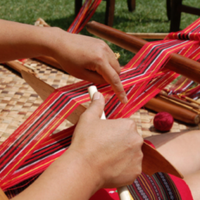
Kalingafornia Laga
Laga, Indigenous weaving traditions from Kalinga
Kalingafornia Laga, a weaving collective of Pilipinx-American women who preserve, promote, and maintain laga (indigenous backstrap weaving traditions from Kalinga), was born from the 2012 ACTA-sponsored apprenticeship between master artist Jenny Bawer Young and Holly Calica. In her attempt to save laga, Jenny envisioned a circle of weavers. While implementing her apprenticeship with Holly, much enthusiasm and interest in weaving was raised in the Filipino-American community, and Kalingafornia Laga took form. This type of weaving is used for blankets, traditional g-strings for men, and belts and skirts for women. The traditional clothing is highly valued regalia and worn during community and family celebrations.
Living Cultures Grant Program
2023
Culture Keeping from Mabilong to the Bay
In 2023, a grant from ACTA’s Living Cultures Grants Program will support intensive weaving lessons for apprentices, to prepare them to teach laga, a Filipino indigenous backstrap weaving tradition from Kalinga.
2021
In 2021, a grant from ACTA’s Living Cultures Grants Program will support a series of community workshops on Kalinga songs, chants, and dances. Entitled Lumin-awa Tako! (Let us Heal Together!), the workshops were designed during the Covid-19 pandemic to offer connection and healing through traditional cultural arts and practices, in an effort counter feelings of isolation, separation, and emotional stress. Two series of workshops, one on dances and the other on songs/chants, will be held during Summer and Fall 2021.
2019
In 2019, a Living Cultures grant supported the continuation of Kalingafornia Laga through demonstrations and weaving sessions. Activities were designed to create safe, healing spaces for the community to address decolonization, reclaim indigenous identity and strengthen community identity-building.
2013
In 2013, a grant from ACTA’s Living Cultures Grants Program established Kalingafornia Laga through a project with Jenny Bawer Young and six apprentices. The project was designed to further the connections between Filipino-Americans and their homeland. Many of the prospective weavers are performing artists who hope to display their work through dance and music presentation. Weekly sessions are free. In 2014, an additional grant expanded the weaving circle, by providing weaving opportunities for children and teen family members of the current weavers.

